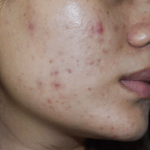
The colder months often bring their own kind of discomfort. Indoors, the hum of central heating feels comforting, but many notice that their skin begins to feel tight, flaky, or more sensitive as the temperature drops. For some, eczema or rosacea flares; for others, fine lines seem more pronounced.
These changes are not imagined. They are a direct consequence of the way warm, dry indoor air alters the skin’s structure and function at a microscopic level. When humidity drops and temperature rises, the skin’s ability to retain water and regulate itself begins to falter.
The skin’s natural hydration system
Healthy skin is not simply “moist”; it is a dynamic barrier designed to retain water while protecting against the external environment. This protective function depends on the outermost layer of the epidermis, the stratum corneum, which behaves like a biological brick wall. The “bricks” are flattened, protein-rich cells known as corneocytes, and the “mortar” is a complex mixture of lipids, primarily ceramides, cholesterol, and free fatty acids, arranged in highly ordered lamellae. These lipids form a continuous, water-resistant matrix that slows evaporation and prevents irritants or microbes from entering.
Inside each corneocyte are natural moisturising factors (NMFs), small hygroscopic molecules including amino acids, urea, and lactate that draw and hold water. When humidity is balanced, this system maintains approximately ten to twenty percent water content in the stratum corneum, enough for enzymatic processes to function optimally and for the barrier to remain flexible and intact.
Sebaceous secretions further support this system. The sebum produced by glands in the dermis spreads across the surface to form a thin lipid film, reducing friction and limiting water loss. Sweat also contributes trace minerals and moisture that help regulate surface pH and support the skin’s microbiome.
When this equilibrium is disturbed, the skin’s ability to retain water is reduced, and the outer layers become brittle. The result is a loss of smoothness, elasticity, and radiance, the hallmarks of what people commonly describe as “winter skin.”
How does central heating disrupt this equilibrium?
Central heating changes the physics of the indoor environment. Warm air can hold more water vapour than cold air. When we increase the temperature inside a room without adding moisture, the relative humidity drops, sometimes falling below twenty percent. At that level, the air becomes actively desiccating, drawing water from any available source, including the skin.
This drives up transepidermal water loss (TEWL), the passive diffusion of water from the living layers of the epidermis into the atmosphere. Within hours of exposure to dry air, the stratum corneum loses water faster than the deeper epidermis can replace it. Corneocytes shrink slightly and the orderly arrangement of intercellular lipids begins to separate. These small structural changes create micro-fissures in the barrier.
At the same time, the enzymes that maintain the skin’s surface, those involved in lipid synthesis and desquamation (or skin shedding and natural exfoliation), depend on water to function. When hydration falls, these enzymes slow, causing a build-up of rough, dead cells at the surface. The skin feels coarse and appears dull, not because of surface residue but because its natural renewal cycle has been interrupted.
This biochemical disruption can also trigger mild inflammation. As the barrier weakens, keratinocytes release cytokines that summon immune cells to the site, producing low-grade irritation and sometimes redness or stinging. For those prone to eczema or rosacea, the drop in humidity exposes underlying weaknesses in skin protein such as filaggrin or lipid synthesis pathways, leading to flares that appear almost as soon as the heating switches on.
Temperature gradients and the microcirculation
Most heating systems maintain indoor temperatures between 20 and 24°C, while the outer surface of the skin naturally sits closer to 32°C. As the air around us warms, this temperature gradient narrows, reducing the body’s drive to circulate warm blood to the skin. The resulting vasoconstriction slows nutrient and oxygen delivery to the epidermis.
Each time you step from cold outdoor air into a heated interior, the small vessels in the skin dilate and constrict in quick succession. Repeated exposure to this cycle makes capillaries more fragile and can heighten reactivity, particularly in people predisposed to flushing or visible redness.
The combination of low humidity, fluctuating temperature, and reduced surface circulation explains why winter skin often feels fragile and sensitive even when your overall routine has not changed.
The invisible role of the microbiome
The skin’s microbiome, its ecosystem of bacteria, fungi, and other microorganisms, depends on a stable environment to thrive. Beneficial microbes prefer a slightly acidic, hydrated surface. As the skin dries and pH rises, this balance shifts. Microbial diversity decreases, and opportunistic species capable of triggering inflammation become more dominant.
This microbial imbalance may account for why some people experience flare-ups of acne, rosacea, or irritation in winter despite reduced exposure to outdoor pollution or ultraviolet light. A dry surface also produces more friction, making the skin feel uncomfortable and reactive to even gentle cleansing.
Why does dry skin look different?
Well-hydrated skin reflects light evenly because its surface is smooth and compact. When water content decreases, the outer layers become uneven and scatter light irregularly. Fine lines appear deeper, texture looks rougher, and the natural glow is replaced by a matte, opaque finish. This dullness is not cosmetic, it is the visible expression of microscopic dehydration and barrier disruption.
Restoring equilibrium
Because the cause of dryness is largely environmental, effective prevention requires attention to both the surrounding air and the barrier itself. The aim is not to smother the skin with products but to restore the conditions that allow it to retain water and repair naturally.
First, restore environmental humidity. Indoor air ideally sits between forty and fifty percent relative humidity, a level that prevents rapid evaporation from the skin. A small humidifier is an easy solution, but even placing bowls of water near radiators or introducing plants into heated rooms increases local moisture. Lowering thermostat settings slightly and using layered clothing maintains warmth without excessively drying the air.
Second, rebuild the lipid structure. Moisturisers that contain ceramides, cholesterol, and fatty acids in balanced ratios most closely replicate the skin’s own barrier composition. Humectant ingredients such as glycerin or urea attract water into the stratum corneum, while light occlusive agents like squalane or dimethicone slow evaporation. Applying these to slightly damp skin after cleansing or bathing traps residual water and enhances penetration.
Third, protect the acid mantle. Hot water and strong detergents strip surface lipids and proteins, disrupting the mildly acidic pH that supports enzyme activity and microbial balance. Shorter, lukewarm showers and gentle, pH-balanced cleansers preserve this environment. Patting the skin dry, rather than rubbing, helps maintain lipid alignment before moisturiser is applied.
Finally, support the barrier from within. Hydration and nutrition are essential for the epidermis to function efficiently. Adequate water intake sustains circulation and nutrient transport. Dietary sources of essential fatty acids, such as oily fish, flaxseed, and walnuts, provide the building blocks for ceramide and cholesterol synthesis. Vitamins C and E, zinc, and copper assist enzymes involved in collagen production and lipid repair, while antioxidants from fruits and vegetables limit the oxidative stress created by dry indoor heat.
Why winter skin feels different
Dry indoor air affects every part of the skin’s physiology. Reduced sebum production, a disrupted microbiome, and slower enzyme activity combine to form a self-perpetuating cycle of dryness and sensitivity. Even well-formulated moisturisers can appear less effective in these conditions because the barrier itself cannot hold water efficiently until its lipid structure is restored.
The good news is that this cycle can be reversed. Once hydration improves and lipids reorganise, enzymes regain activity, the microbiome rebalances, and the skin regains its natural softness. The change is gradual but cumulative.
Rebalancing the skin through seasonal care
The solution is not to abandon central heating but to adapt routines in response to the indoor environment. Winter skincare should become more restorative and protective, prioritising barrier repair over exfoliation or active resurfacing. Richer emollients, gentler cleansing, and consistent hydration work together to rebuild the structure that central heating disrupts.
Small environmental adjustments, humidified air, moderate room temperature, and adequate internal hydration support these efforts. Within days, tightness and flaking begin to ease, and over time, the barrier regains the ability to regulate itself naturally.
The takeaway
Central heating makes modern life more comfortable but changes the physics of our surroundings in ways that directly affect skin biology. Warm, dry air accelerates water loss, disrupts lipid organisation, alters the microbiome, and slows the enzymes responsible for renewal. The result is dryness, irritation, and increased sensitivity.
The solution lies in restoring what the environment removes: moisture, lipids, and equilibrium. By understanding the mechanisms behind these changes, it becomes clear that true improvement comes not from temporary surface fixes but from rebuilding the barrier itself. With the right care, the skin remains calm, supple, and resilient, even through the coldest months.
If winter dryness or sensitivity is affecting you, book a consultation at our medical dermatology clinic on Harley Street. Our expert dermatologist can assess your skin and recommend treatments to keep your skin resilient all year round.





